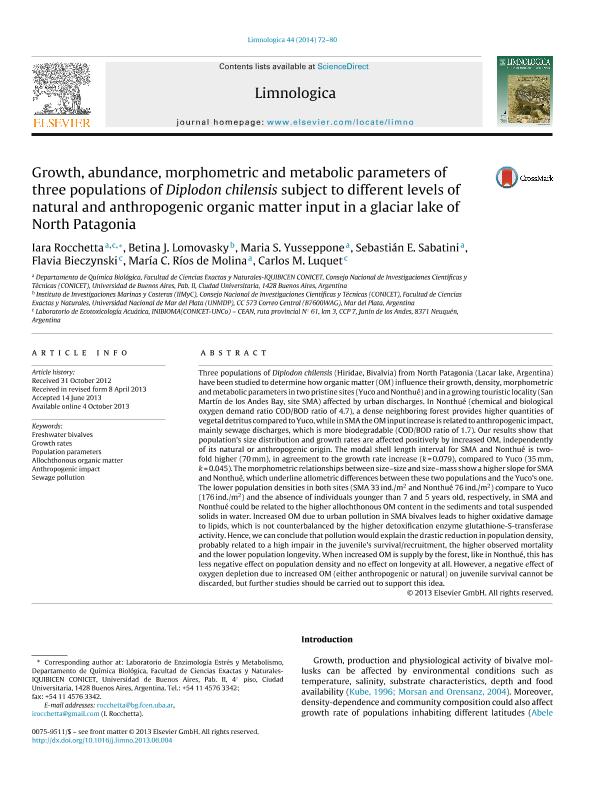Artículo
Growth, abundance, morphometric and metabolic parameters of three populations of Diplodon chilensis subject to different levels of natural and anthropogenic organic matter input in a glaciar lake of North Patagonia
Rocchetta, Iara ; Lomovasky, Betina Judith
; Lomovasky, Betina Judith ; Yusseppone, Maria Soledad
; Yusseppone, Maria Soledad ; Sabatini, Sebastian Eduardo
; Sabatini, Sebastian Eduardo ; Bieczynski, Flavia
; Bieczynski, Flavia ; Ríos de Molina, María C.; Luquet, Carlos Marcelo
; Ríos de Molina, María C.; Luquet, Carlos Marcelo
 ; Lomovasky, Betina Judith
; Lomovasky, Betina Judith ; Yusseppone, Maria Soledad
; Yusseppone, Maria Soledad ; Sabatini, Sebastian Eduardo
; Sabatini, Sebastian Eduardo ; Bieczynski, Flavia
; Bieczynski, Flavia ; Ríos de Molina, María C.; Luquet, Carlos Marcelo
; Ríos de Molina, María C.; Luquet, Carlos Marcelo
Fecha de publicación:
06/2013
Editorial:
Elsevier Gmbh
Revista:
Limnologica
ISSN:
0075-9511
Idioma:
Inglés
Tipo de recurso:
Artículo publicado
Clasificación temática:
Resumen
Three populations of Diplodon chilensis (Hiridae, Bivalvia) from North Patagonia (Lacar lake, Argentina) have been studied to determine how organic matter (OM) influence their growth, density, morphometric and metabolic parameters in two pristine sites (Yuco and Nonthué) and in a growing touristic locality (San Martín de los Andes Bay, site SMA) affected by urban discharges. In Nonthué (chemical and biological oxygen demand ratio COD/BOD ratio of 4.7), a dense neighboring forest provides higher quantities of vegetal detritus compared to Yuco, while in SMA the OM input increase is related to anthropogenic impact, mainly sewage discharges, which is more biodegradable (COD/BOD ratio of 1.7). Our results show that population’s size distribution and growth rates are affected positively by increased OM, independently of its natural or anthropogenic origin. The modal shell length interval for SMA and Nonthué is two-fold higher (70 mm), in agreement to the growth rate increase (k=0.079), compared to Yuco (35 mm, k=0.045). The morphometric relationships between size-size and size-mass show a higher slope for SMA and Nonthué, which underline allometric differences between these two populations and the Yuco’s one. The lower population densities in both sites (SMA 33 ind./m2 and Nonthue 76 ind./m2) compare to Yuco (176 ind./m2) and the absence of individuals younger than 7 and 5 years old, respectively, in SMA and Nonthué could be related to the higher allochthonous OM content in the sediments and total suspended solids in water. Increased OM due to urban pollution in SMA bivalves leads to higher oxidative damage to lipids, which is not counterbalanced by the higher detoxification enzyme glutathione-S-transferase activity. Hence, we can conclude that pollution would explain the drastic reduction in population density, probably related to a high impair in the juvenile’s survival/recruitment, the higher observed mortality and the lower population longevity. When increased OM is supply by the forest, like in Nonthue, this has less negative effect on population density and no effect on longevity at all. However, a negative effect of oxygen depletion due to increased OM (either anthropogenic or natural) on juvenile survival cannot be discarded, but further studies should be carried out to support this idea.
Archivos asociados
Licencia
Identificadores
Colecciones
Articulos(IIMYC)
Articulos de INSTITUTO DE INVESTIGACIONES MARINAS Y COSTERAS
Articulos de INSTITUTO DE INVESTIGACIONES MARINAS Y COSTERAS
Articulos(INIBIOMA)
Articulos de INST. DE INVEST.EN BIODIVERSIDAD Y MEDIOAMBIENTE
Articulos de INST. DE INVEST.EN BIODIVERSIDAD Y MEDIOAMBIENTE
Articulos(IQUIBICEN)
Articulos de INSTITUTO DE QUIMICA BIOLOGICA DE LA FACULTAD DE CS. EXACTAS Y NATURALES
Articulos de INSTITUTO DE QUIMICA BIOLOGICA DE LA FACULTAD DE CS. EXACTAS Y NATURALES
Citación
Rocchetta, Iara; Lomovasky, Betina Judith; Yusseppone, Maria Soledad; Sabatini, Sebastian Eduardo; Bieczynski, Flavia; et al.; Growth, abundance, morphometric and metabolic parameters of three populations of Diplodon chilensis subject to different levels of natural and anthropogenic organic matter input in a glaciar lake of North Patagonia; Elsevier Gmbh; Limnologica; 44; 6-2013; 72-80
Compartir
Altmétricas



